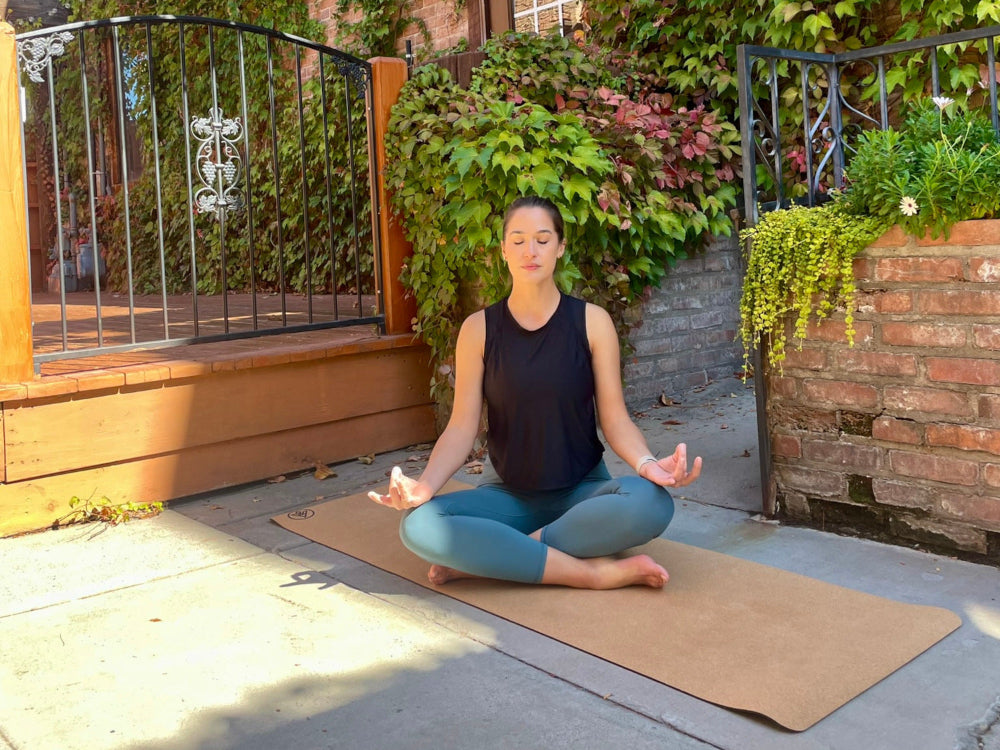
Karuna Mudra - Gesture of Compassion
Jack UtermoehlShare
Karuna Mudra (Gesture of Compassion)
Sanskrit Name: Karuṇā Mudrā - करुणा मुद्रा
English Translation: Gesture of Compassion
Phonetic Spelling: Kah-ROO-nah Moo-Drah
Karuna mudra, or the gesture of compassion, is a gentle hand gesture that invokes feelings of empathy, kindness, and compassion towards oneself and others. The Sanskrit word karuna means compassion. This mudra opens the heart, helping to release emotional tension and cultivate a deep sense of connection with the world around us.
By softening the muscles of the heart, chest, and throat, karuna mudra allows emotional healing and promotes an inner sense of peace and empathy.
This mudra is not only ideal for seated meditation but also works well during certain yoga poses like Vrksasana (tree pose) or as a modification for eagle arms in Garudasana (eagle pose).

Instructions to Perform Karuna Mudra
Find a comfortable seated position with your spine upright. Take a few slow breaths to center yourself.
Hand Position: Cup your left hand and place it in front of your heart, palm facing inward. Cup your right hand and place it over your left hand, resting the fingertips of your left hand at the base of your right fingers. Keep the gesture soft and relaxed in front of your heart center.
Posture: Sit in sukhasana (easy pose), stand in garudasana (eagle pose), or sit comfortably in a chair with your feet flat on the ground.
Breathing Technique: Inhale deeply through the nose, expanding the chest. As you exhale, focus on the feeling of compassion and warmth in your heart. Allow your breath to flow smoothly, releasing any tension in the chest, throat, or mouth.
Duration: Practice karuna mudra for 2-5 minutes.
Benefits of Karuna Mudra
Karuna mudra is a heart-centered gesture that helps relieve emotional tension and facilitate compassion and empathy.
Physical Benefits: Releases tension in the heart, chest, throat, and mouth muscles. Improves relaxation and breathing.
Mental Benefits: Helps clear mental stress, evoking a sense of peace and focus.
Emotional Benefits: Encourages feelings of compassion, empathy, and kindness toward oneself and others. Reduces emotional stress.
Spiritual Benefits: Opens the heart chakra, promoting connection to others and emotional healing.
Capture your insights and deepen your connection with our Yoga Journal.Elevate Your Mudra Practice
Symbolism and Meaning of Karuna Mudra
The word karuna means compassion, and this mudra connects the practitioner to feelings of empathy and love for others. By cupping the hands together over the heart center, this gesture symbolizes the nurturing of love and kindness within. It helps create a flow of compassionate energy from the heart, allowing the practitioner to share this warmth with others.
Karuna mudra activates Anahata (heart) chakra, promoting emotional healing and connection. It’s a powerful tool for those looking to deepen their empathy and emotional resilience.
When to Practice Karuna Mudra
Karuna mudra can be practiced during meditation or asana (physical postures) to enhance feelings of compassion and emotional balance. It is useful during yoga asanas like vrksasana (tree pose) or garudasana (eagle pose) as it naturally forms as part of the pose..
Use this mudra when seeking emotional release, empathy, or to relax and release tension in the chest. A duration of 2-5 minutes is recommended.
Contraindications for Karuna Mudra
Karuna mudra is gentle and suitable for all practitioners. Those with hand or wrist discomfort should practice mindfully or adjust the hand position as needed.
Additional Insights on Karuna Mudra
Affirmations: "I am open to compassion and kindness." / "I give and receive love and empathy freely."
Visualization: While holding karuna mudra, visualize a warm light surrounding your heart, radiating outward as a symbol of your compassion and kindness to yourself and others.
Associated Chakras: Karuna mudra primarily activates the Anahata (heart chakra), promoting emotional balance, empathy, and healing.
Paired Asanas: Works well with vrksasana (tree pose) or garudasana (eagle pose) to foster emotional balance and focus.
Related Pranayama: Pair karuna mudra with deep belly breathing or alternate nostril breathing (nadi shodhana) to calm the heart and promote emotional healing.
Meditation Techniques: Karuna mudra is ideal for loving-kindness meditation (metta meditation), focusing on empathy, compassion, and emotional release.
Variations and Modifications
Alternative Hand Positions: Anjali Mudra, Hridaya Mudra
Adaptations for Beginners: Beginners can start by practicing karuna mudra for shorter periods, such as 2-5 minutes, and gradually increase the time. Resting your hands on a cushion can provide support during longer sessions.
—— 🕉 ——

Personal Insights
Karuna mudra has been my go-to mudra for yoga poses that place my hands in front of my heart. When teachers cue up Anjali mudra (hands at heart center), I instead opt for Karuna mudra.
I feel peace and flow when I hold Karuna mudra such that my poses, and by extension my whole practice, find both ease and steadiness which is a crucial aspect of following the 8-limbs of yoga which describe asana (physical posture) as “sthira sukham asanam” which translates to “asana is a steady and comfortable posture.”
I find this experience especially vital during my hot yoga vinyasa, yin, and sometimes combined VinYin yoga practices where my mind is already playing games on me to stop. Instead I want to keep pushing forward but there’s a balance of compassion for my body in this dance. Finding the empathy of the moment allows me to realistically check-in on my body’s condition and make decisions appropriately from there.
I feel the symbolism and strength of Karuna mudra is in part its shape of upward flowing energy symbolic of the kundalini energy flowing upwards into my heart.
Give it a try and let me know how you feel practicing Karuna mudra in place of other heart centered mudras during your own yoga practice.











